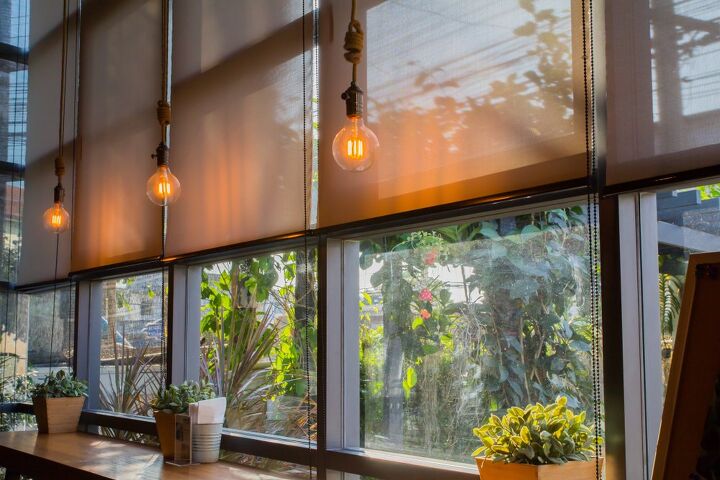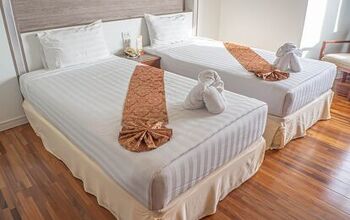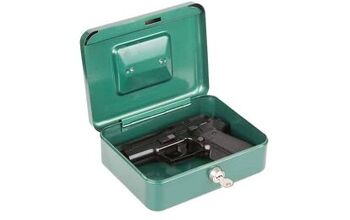10 Affordable Alternative To Blinds (with Photos)

Blinds are useful for creating privacy and keeping the sun out, but they don’t meet the taste of every homeowner. Many homeowners would prefer an alternative that allows for more or less light or is simply more visually appealing. Navigating the world of covering your windows can be tricky, so what are the best alternatives to blinds?
Shutters, plant shelves, frosting spray, macrame, and stained glass window films are the best alternatives to blinds. Hanging plants, lace, beads, and wooden shades are also great substitutes for traditional blinds. Curtains, shudders, and wooden shades are the best choices if you want to completely block light in the room.
Let’s take a deep dive into the best alternatives to blinds, and why each one is unique.
10 Beautiful and Functional Alternatives to Blinds
1. Shutters
Shutters a great alternative to blinds if you want something that adds character to the room. You can find shutters that match the room aesthetic of the room, or options that create a contrast. The great thing about shutters is that there is no shortage of options that suit any look, such as rustic or modern.
Shutters are easy to paint so you can match them to your liking and the room with no trouble. Barn door-style shutters have become increasingly popular in recent years, and they’re great for keeping light out. You can easily open shutters to let light in, and close them when you need privacy or time to cool off.
Decent sets of shutters start at $30 but spending closer to $50-$60 can get you premium shutters. You don’t need blinds if you have a set of shutters that you are happy with. There are dozens of types of shutters, such as wood, fiberglass, and vinyl, so the options are endless.
Pros- Variety of options
- Can be painted
- Affordable
- Blocks out light
- Constantly visible
2. Plant Shelves
This option might not block the light, but plant shelves are a great substitute for blinds. Plant shelves are a double whammy as they create a distinct look in the room, and the light causes the plants to thrive. Not only will you have a fun and unique substitute for blinds, but you’ll have gorgeous plants to look at.
The right combination of wooden or glass plant shelves with plants that need direct sunlight is perfect. This can only go wrong if you select plants that don’t require much sun, or if you neglect them altogether. Do your homework and look for plants that thrive in direct sun, such as basil and jade plants.
It is fun to experiment with different plants and see which ones will best complement the room. Make sure to select a material, such as wood, that is strong enough to support your plants. You can even select pots and planters that match the windowsills or the walls in the room for a nice touch.
Pros- Visually appealing
- Improves air quality
- Several materials to choose from
- Customization
- Requires maintenance/watering
3. Frosting Spray
Frosting spray is one of the easiest and most unique alternatives to blinds that money can buy. It’s as easy as spraying the windows with the frosting agent of your choice and waiting for results. The frosting spray creates a nice frost over the window that helps obscure the sunlight.
You can also use frost etching cream if you want to permanently frost your windows. However, frosting spray is a great option if you want to give frosted windows a try without committing. The good news is that frosting spray is generally waterproof, so cleaning the windows is easy.
Frosting spray is a great alternative to blinds if your windows get a lot of sun and you want to minimize it. The frosting spray won’t completely get rid of the sunlight, but it will help to dampen it greatly. Check out these 29 types of window blinds.
Pros- Minimizes the sunlight
- Waterproof
- Affordable
- Not permanent (cream is permanent)
- Can be difficult to apply
4. Macrame
Macrame is a type of textile that goes with various home aesthetics from rustic to modern. The intricate and detailed knots that macrame textiles provide are hard to beat and creates a memorable visual. You can hang macrame-like drapes so you can pull them open or shut them based on your personal preference.
Macrame effectively works just like standard drapes, they are just generally more visually appealing. You could also purchase macrame wall hangings if you have small windows that you need to cover. Macrame can still let in a small amount of light, but it beats leaving the windows uncovered.
Wall hangings can be found for as little as $10, and macrame drapes cost between $20 and $90 or higher. Macrame goes best with Moroccan and Bohemian looks, but it will look great no matter what your home’s aesthetic is.
Pros- Unique design
- Suits many styles
- Affordable
- Limited options
- Not a sturdy material
5. Stained Glass Window Film
Stained glass is beautiful, but it’s far too expensive to justify for many homeowners. Luckily, you can settle for stained glass window film which gives all of the benefits and appearance of traditional stained glass. Authentic stained glass can cost as much as $1,000 per panel or more, but stained glass window films cost as low as $50.
Stained glass window film is temporary and removable, so it’s not a risky alteration at all. You can experiment with stained glass window film and find the color scheme to match the room. Similar to a real stained glass window, a window film creates a colorful glow when the sun hits it.
Some homeowners put stained glass window film on each side of the glass for a more consistent look. Look into stained glass window film if you want an alternative to blinds that won’t cost you an arm and a leg.
Pros- Removable
- Convincing
- Inexpensive
- Not as nice as authentic stained glass
- Can peel away
6. Hanging Plants
Consider hanging plants as an alternative to blinds if you have small or medium-sized windows. Plants such as ferns or air plants like Spanish moss look great hanging in front of your window. You can buy hanging plant rigs for $40 or less, or you can rig one up on your own.
Hanging plants aren’t great for large windows because it is difficult to cover the entire window. This is a great option if you don’t want to block the light out completely like with blinds. However, you won’t be able to adjust your hanging plants in the way that you can with blinds or shades.
The plants will look great due to the access to sunlight, especially if you maintain them well. Look for plants that you will want to see every day and take special care of them. Put hanging plants in front of your windows if you want a lively way to brighten up the window.
Pros- Let’s in a lot of sunlight
- Inexpensive
- Easy to build DIY
- Difficult to adjust
- Works best for smaller windows
7. Curtains
Curtains allow you to more easily limit or maximize the light that enters through your windows compared to blinds. You can easily pull curtains shut or open them up to allows as much or little light as possible into the room. There are curtain options for any price range, and you can find great curtains for as little as $40.
Some curtains are sheerer than others, and some options are dense and allow less light in. Blackout curtains are a great choice for windows in your bedroom or direct sunlight. Curtains come in all shapes and sizes, and it’s easy to find a set that matches the room overall.
Look for curtains that either contrast or match the room, and you’ll have one of the best alternatives to blinds.
Pros- Great control over light
- Countless options
- Affordable
- Becomes dirty easily
- Hard to find a perfect fit
8. Wooden Shades
Wooden shades let a small of light in, but they can greatly help control a room’s temperature. You can easily raise or lower wooden shades to fit the lighting situation that you need the most. Small bits of light typically spill through wooden shades, but not enough to be overwhelming.
Expect to pay between $30 and $100 for a great set of wooden shades to cover your windows. There is no limit to what kind of aesthetic you can pair wooden shades with. Wooden shades complement rustic, country-style, Bohemian designs, and more.
Be careful if you have pets as it is easy for cats specifically to tear wooden shades down. Choose wooden shades if you want an alternative to blinds that boasts a unique visual flair.
Pros- Visually distinct
- Blocks light well
- Compliments any aesthetic
- Not very sturdy
- Doesn’t control the temperature well
9. Lace
Hang lace in the front of your windows if you want to create a unique look. Sunlight will spill through the lace, but the fabric will help to soften the light and make it less intense. Lace is a thin and semi-sheer material that looks quite distinct when the sun shines through it.
Rooms with white walls or a soft color palette can benefit from lace in the front of the windows. Lace is not a great substitute for blinds if you want to keep the light out, however. Only choice lace if you don’t mind that some sunlight will still peer through your windows and into the room.
You can pull the lace back to allow for full sunlight if that’s what you want, and it’s easy to hang. Be careful as lace can get dirty easily, and you’ll need to clean it as often as possible.
Pros- Softens the light
- Looks beautiful
- Easy to hang
- Gets dirty easily
- Doesn’t block the sun
10. Beads
Hanging beads are unique and evoke a Bohemian and Moroccan look that is hard to pass up. You can hang beads in front of a window on your own if you have done other DIY projects. Beads allow light to spill through, but they minimize the direct sunlight.
You can rig the hanging beads so that they can pull to the side with a drawstring to allow more or less light in. Pre-assembled hanging beads are available for between $20 and $50, but premium beads cost over $100. Hanging beads create a relaxed, retro aesthetic that adds a unique value to the room right away.
Pros- Unique style
- Affordable
- Easy to adjust
- Doesn’t fully block the light
- Lack of privacy
Related Questions
How long do blinds last?
You can expect your blinds to last you 8 years, if not longer. Alternatives such as shutters are a better choice if you want a longer-lasting window cover.
Do blinds keep heat in?
Blinds help keep a minimal amount of heat in during the winter, but not much. They are better at keeping heat out of the house during the cold months than keeping heat inside. Curtains are better at keeping in than blinds are.
What Did We Learn?
Shutters, plant shelves, and frosting spray are the best alternatives to blinds that money can buy. Macrame and lace are great options if you’d rather use a fabric that you can easily remove. Hanging beads are another great choice, but they aren’t great for privacy and completely blocking the sun.
Wooden shades and curtains are the best options for totally keeping the sunlight out of the room. You can also use a stained glass window film if you want to create a unique visual style that accentuates the color palette of the room. Hanging plants are a visually appealing alternative to blinds because they create a vibrant look.
The blinds alternative that you choose is based on your visual style and how much maintenance you want to do. Thin alternatives, like macrame and lace, are not the best if you have pets or a dust problem in the house. Each of the aforementioned alternatives to blinds is worth considering if you would rather not use traditional blinds.
Related Articles

Nick Durante is a professional writer with a primary focus on home improvement. When he is not writing about home improvement or taking on projects around the house, he likes to read and create art. He is always looking towards the newest trends in home improvement.
More by Nick Durante
























![The 5 Best Angle Grinders – [2022 Reviews & Buyer's Guide]](https://cdn-fastly.upgradedhome.com/media/2023/07/31/9071326/the-5-best-angle-grinders-2022-reviews-buyer-s-guide.jpg?size=350x220)












